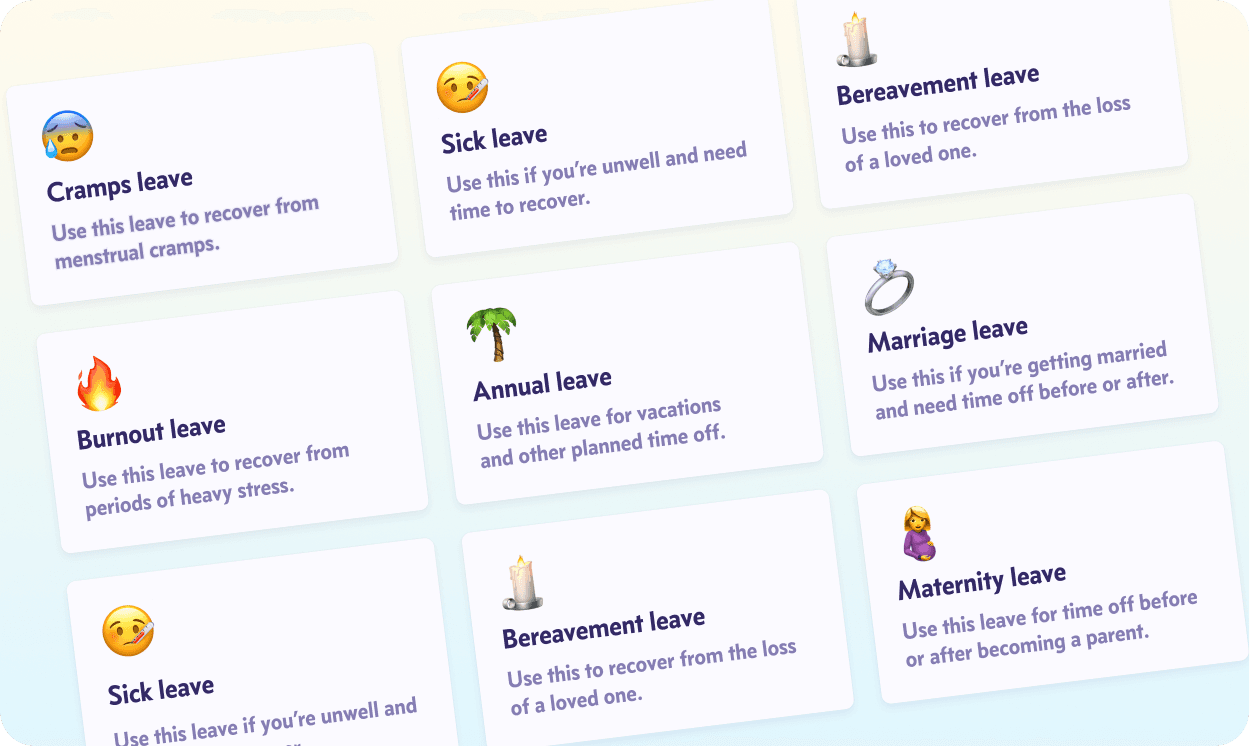What is Flexible Time Off (and how you can make it work)
Nov 16, 2022

"Flexible" is both a buzzword and the mark of a shift in office culture. Paid time off is also becoming flexible, giving employees more freedom in making choices for their wellbeing.
But like all new things, flexible time off has also seen a lot of scepticism, with people asking questions like:
What if employees abuse our flexible time off policy?
How does one keep track of who is at work and who isn't?
What takes priority during critical workweeks: a project or an employee's leave request?
What is flexible time off?
Flexible time off (FTO) is a policy that encourages teammates to enjoy their paid time off without the pressure of "use it or lose it" mandates. In most cases, time-off hours don't need to be earned or accrued by employees; they're given in good faith. The natural transparency that comes with flexible time off also ensures that no one needs to fake an illness for a day off, or slink out of work silently.
Flexible PTO is not all about taking time off when you please, although that's a part of it. It is more about trusting colleagues to plan their time and prioritise both work and wellbeing. It also opens up many learning and growth opportunities for teams that might've been out of reach otherwise.
In many organisations, flexible time off equals an unlimited PTO policy with no explicit limits on how many days one can take. However, given that unlimited PTO isn't the best policy out there, most companies prefer to give employees a generous number of vacation days to use for whatever reasons. This reduces the pressure on employees to fit the category, like waiting for a common cold to take sick leave, or needing to plan a proper vacation to take casual leave.
Flexible time off policies need to be supported by a culture that isn't obsessed with being present all day everyday. It means ensuring that work goes on as usual even when someone is on leave, without hindering progress or putting extra pressure on colleagues.
The advantages of flexible time off (FTO)
When it's got an empathetic office culture to bank on, flexible time off has a whole host of benefits for organisations and employees alike:
Better employee productivity
Flexible time off encourages employees to look after their wellbeing whenever they need to, without having to wait for a reason. Those who do this regularly tend to be happier, and that makes them more productive.
Prevent burnout
Taking breaks from work helps employees replenish their energy and avoid dark patterns or unhealthy workplace habits. As much as it seems like it, work doesn't always have to come first — and more control over their schedules also means that employees can prioritise what matters most at that point. There's also the matter of decision fatigue while trying to book time off — having a flexible time off policy lessens the psychological stress and makes the process much easier.
Higher respect for diversity
Flexible time off is often an indicator that your organisation respects individual needs and circumstances. It shows that you're not putting employees inside boxes or homogenising them but instead respecting them for who they are as individuals. Therefore, a flexible time off policy is universally respectful of any reason to take a break from work!
The disadvantages of flexible time off (FTO)
There's a flip side to every coin, and that's the case with flexible time off, too. Here are the drawbacks of instituting a flexible time off policy:
Unclear guidelines
Clarity and transparency are super valuable in any organisation, but flexible time off policies can tend to be murky. If there are unclear or no guidelines on taking time off, employees might feel guilty about taking a break or resist taking one entirely. As a result, your problem becomes not overuse of time off, but underuse — and that's dangerous, too. Overworked employees burn out faster and could even leave the organisation quicker than others.
Time-off conflicts within teams
Flexible time off can rapidly spiral into teammates taking a break all at the same time. Such leave conflicts can interfere with capacity planning and lead to a lot of awkward conversations. One way to reduce this risk is to ask employees to inform their colleagues and managers well in advance when they're scheduling time off.
Potential for overuse
Flexible time off policies can leave room for overuse or lack of communication, which can throw a wrench in the works. However, it's worth mentioning that chronic absenteeism and overuse often have other underlying causes that can affect productivity and morale — so don't forget to look into those!
How to encourage flexible time off (FTO) in a healthy manner
The foundation of a healthy flexible time off policy is understanding and agreeing that employees are responsible for their work, time off, and wellbeing. And as we said before, it needs to be diversity-friendly and empathetic!
Talk to your teams about it
Communicate, communicate, communicate: that's the first step to encouraging flexible time off. It's important to let your team know that such a policy exists, and ideally clarify any questions they might have. We're huge advocates of writing down at least a one-pager about your flexible time off policy so the information's always readily available. Don't hold back on the details as they'll reduce the pressure on your teams while taking time off!
Design your flexible time off policy accordingly
Your leave policy should be the touchstone for any conversations relating to flexible time off. Depending on the route you take, you might want to specify the number of days everyone gets (or at least a minimum number they need to take). It also helps to document what to do in the case of circumstances such as:
bereavement
mental or physical health issues
public holidays
Use a leave management tool to manage flexible time off
Leave management software simplify the process of booking and managing time off. They're convenient when you have an unlimited or flexible time off policy, because then you won't need to record absences manually. You'll save time and energy spent on updating spreadsheets and emailing HR — and that's always a win, right?
We'd recommend picking leave management software that is customisable, empathetic, prioritises team communication, and flags leave conflicts. You want to reduce the pressure on employees — and what's more ideal than a leave management software that gives them all the information they need to do so?
You've technically already found one that checks all those boxes: Pause! It's people-first, transparent, and easy to use. Pause automates many processes that inspire better communication and trust, including daily leave summary notifications, leave conflict flags, and organisation-wide time-off visibility.
The final word on flexible time off
Flexible time off works well for some organisations, not so much for others. It's quite the trial-and-error process and will take time to perfect. If we were to offer one last piece of advice, it would be this: keep things as clear and transparent as possible, and you'll see the results you were hoping for!


